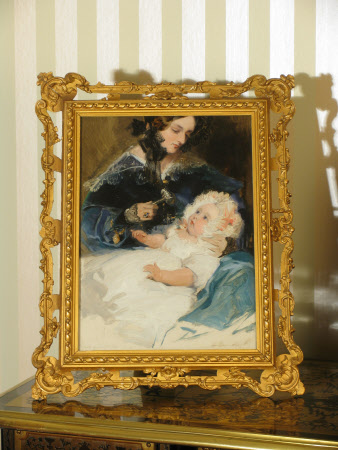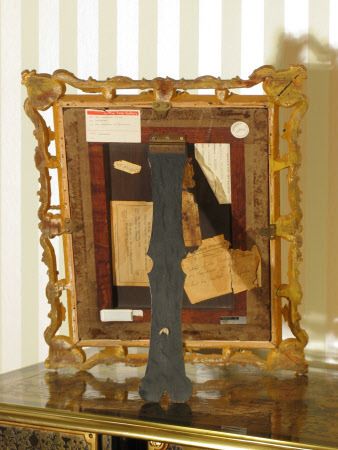Lady Louisa Jane Russell, Duchess of Abercorn (1812-1905) with her Daughter Lady Harriet Georgiana Louisa Hamilton, later Countess of Lichfield (1834-1913)
Sir Edwin Henry Landseer RA (London 1802 - London 1873)
Category
Art / Oil paintings
Date
1834 (monogrammed and dated)
Materials
Oil on slate
Measurements
356 x 254 mm (14 x 10 in)
Place of origin
England
Order this imageCollection
Shugborough Estate, Staffordshire
NT 1271075
Caption
Landseer seems to have snatched up a panel and made this sketch spontaneously, not leaving himself room for the whole of the Marchioness's head. He subsequently began, but never completed, a more elaborate version on copper (Tate). The artist had a uniquely informal relationship with the highest echelons of the Whig aristocracy, but particularly with the 6th Duke of Bedford and his much younger second wife, Georgiana, daughter of the 4th Duke of Gordon. This is just one of a succession of portraits and fancy pictures that he painted of their two youngest daughters.
Summary
Oil painting on slate, Lady Louisa Jane Russell, Duchess of Abercorn (1812-1905) with her Daughter, Lady Harriet Georgiana Louisa Hamilton, later Countess of Lichfield (1834-1913) by Sir Edwin Henry Landseer (1802-1873), signed bottom right: The Doune 1834 E.L. Portrait of a young woman, seated with a baby on her knee, holding a rattle in her right hand.
Full description
According to the sitter's son, Lord Frederic Hamilton: "Landseer preferred painting on panel, and he never would allow his pictures to be varnished .... none of the Landseers my family possess have ever been varnished" (i) Sadly, even if that remains the case, most others have been, including this, which may help to account for their often too glistening appearance. Here, he seems to have snatched up a panel and to have made this spontaneous sketch upon it, without calculating whether or not he would be able to get all of the mother's head in. The panel is too slight to have admitted of enlargement. Instead, the artist subsequently painted two derivatives, an unfinished sketch in the collection of the present Duke of Abercorn ; and another only partially completed painting on copper, in the Tate Gallery, creating a rudimentary setting for the figures, and adding a large bloodhound to the left. It is this last that was engraved by J. Thomson for the Book of Beauty in the same year. The informality of this picture of the Marchioness and her child takes us straight to the heart of Landseer's remarkable relationship with the highest echelons of the Whig aristocracy. The son of a deaf and eccentric engraver, he became the intimate friend of "dooks and doochesses", but without either curbing his difficult temperament or compromising his art; he could not even tolerate being watched when painting, nor would he let anyone see his pictures until they were finished. (ii) The tone of his intercourse with the male members at least of these great families is perhaps best caught by J.G. Lockhart's description of a dinner that Landseer gave for his cronies in 1851: "The dinner was good, but very queer and conceited, a mixture of finery and the fast school ... The only ohter plebeian was Swinton. We had Lords Abercorn, Ossulstone, Mandeville and Ed. Russell, and they all called the knight "Lanny", and he called them "Ossy," "Many," "Ned," Abercorn only "Marquis" - I suppose he being the only one that pays. All dog, and horse, stag, and Queen for talk .... and when I left them at half-past ten, they were all starting for some place where a new American game of rackets is played by gaslight, Lanny and all." Whole albums of ink drawings of society figures, veering in character from quick sketches to caricatures, and some still in the possession of their descendants, including the Abercorns, give a further glimpse of his opportunities for close observation of their sitters. Yet he was an equal favourite with their womenfolk, and even - for a period - with the Queen herself. It was partly a reflection of Landseer's brilliant and entertaining - but ultimately unstable - personality, and partly a consequence of the fact that his art and its subject-matter - dogs, game, hunting, children, and the wild Scottish landscape - caused them no disquiet, but were a familiar and favourite part of their daily lives. What is more, certain of these ducal families, like the painter, had recently discovered the remoteness of the Highlands, where all these things could be enjoyed in conditions of - relative - simplicity, in huts, tents, or simply-constructed lodges, that were the mid-19th-century equivalent of escape to petits appartements, trianons, and ermitages, from the formal constraints of existence at court. Amongst the greatest of these figures, and the closest of Landseer's friends, were John, 6th Duke of Bedford (1766-1839) and his much younger second wife, Georgiana (1781-1853), daughter of the 4th Duke of Gordon, whom the Duke had married in 1803. Landseer was a frequent visitor not just to Woburn Abbey (where he is first recorded in February 1823), but to Endsleigh in Devon, and to The Doune and Glenfeshie in the Highlands. Amongst the pictures that they bought or commissioned from Landseer were portraits of their two youngest sons, Lord Cosmo Russell on his pony Fingall, or The Young Mountaineer (1824, The Duke of Abercorn) and Lord Alexander Russell on his pony Emerald, or The First Leap (1829, Guildhall Art Gallery, London); and his great Rubensian-cum-Snydersian exercise in Border history, The Hunting of Chevy Chase (1825-26, Birmingham City Museums & Art Gallery). Gossip, fanned by her step-children, and biliously recorded by the socially impossible Benjamin Robert Haydon, went so far as to accuse Landseer of having the Duchess, whom he first painted in 1823 for a portrait engraved in The Keepsake, for his mistress, and of fathering her youngest child, Lady Rachel Russell (1826-1898), later Lady James Butler. This last was indeed born five years after her closest sibling. Landseer's mental breakdown in 1840 was also attributed by some to the widowed Duchess's refusal to marry him. But, whereas the Duke, as an 18th-century survival, might perhaps have turned a blind eye to the relationship, because of his own pleasure in the artist's company, it seems less probable that the Duchess's children should have, not least because Landseer was a contemporary of the oldest of them . Rather does the artist always seem to have had the gift of getting on with older women, as witness his relationship with his aunt, Miss Barbara Potts, the Queen's dresser and confidante; Miss Marianne Skerrett, and his guardian once his mind had gone, Mrs. Pritchard. He painted both straight portraits of the two youngest daughters, Lady Louisa and Lady Rachel, and subject pictures using them openly as his models, including Lady Louisa Russell feeding a donkey (drawing of 1825, etched by Jessica Landseer 1826), Little Red Riding Hood (Lady Rachel, 1831, first engraved by J.H. Robinson) [& ?Ly. Louisa R. feeding a donkey (Lenni, p.43)], Cottage Industry (Lady Louisa, 1831, first engraved by F.C. Lewis), Actress at the Duke's (Lady Rachel, 1832, engraved by C. Rolls), Pets (Lady Rachel, 1832, engraved by W.H. Watt; a variant of this was etched as Lady Rachel Russell with a pet fawn by the Duchess, who etched other works by Landseer too), and Twelfth Night (Lady Louisa, 1836, first engraved by J.H. Robinson). Landseer may, however, have felt some attraction to these daughters, and particularly to Lady Louisa. For it is interesting that he, the confirmed bachelor, should have painted not just one, but three versions of this tender maternal study of her, just as he was later to paint a maternal study of 'Loo' - Louisa Stuart Mackenzie, Lady Ashburton, with whom he undoubtedly was in love . Moreover, Cottage Industry , which shows Lady Louisa as a Highland woman crocheting at a window, is in turn related to his painting of A Highland Breakfast (exh. 1834, Sheepshanks coll., Victoria & Albert Museum) , and its associated oil sketches, C.G. Lewis's etching after Landseer of The Highland Mother , and Landseer's drawing of the woman wearing the same cotton cap. The painting shows a Highland woman suckling her child, as a miscellany of dogs, one of whom has three suckling puppies, take their milk from a bowie. The dark-haired Highlander is curiously reminiscent of the Marchioness, and is made finer-featured, and if anything more like her, between the drawing and the final painting. So much so, that one is strongly tempted to wonder whether there was not some transference between the present decorous representation, and the earthier, more natural one in A Highland Breakfast, in Landseer's mind, and whether he did not portray the Highland woman as he would like to have, but could not for reasons of decorum, portray the Marchioness.There are also at Shugborough by Landseer an ink drawing of Lord Hamilton and Lady Harriet Hamilton with a Fortune-Teller (1843), and a coloured chalk drawing of Lady Harriet Hamilton. i) The Days before Yesterday, p.21. On p.19 he says that Landseer had painted five portraits of his mother, but only names the two fancy pictures of her that were engraved, Cottage Industry and The Mask (by which he seems to mean Twelfth Night). Nonetheless, if he does not speak directly of any of the three versions of the present composition, he makes a charming veiled allusion to it in his frontispiece, a photograph of Louisa, Duchess of Abercorn, in her ninety-first year, with her grandson's grandson, Lord Dunglass [who is none other than Sir Alec Douglas-Home, Lord Home!], which is almost a mirror-image of it, seventy years on. ii) Algernon Graves, Catalogue of the Works of the late Sir Edwin Landseer, R.A. [1876], p.18, no.206. iii) Inv. 3008; Graves, ibid. iv) J.C. Horsley, Recollections of a Royal Academician, ed. Mrs. Edmund Helps, 1903, p.276. (adapted from author's version/pre-publication, Alastair Laing, In Trust for the Nation, exh. cat., 1995)
Provenance
James, 1st Duke of Aberdeen (1811-85); by whom lent to RA in 1874); thence to and by descent from the baby represented, Lady Hamilton, who married Thomas, 2nd Earl of Lichfield in 1855; until Shugbourogh, with its park and contents of the state rooms, was offered in part-payment of death-duties to the Treasury, and transferred to the National Trust, following the death of Thomas, 4th Earl of Lichfield (1883 - 1960)
Credit line
Shugborough, The Anson Collection (National Trust)
Marks and inscriptions
Recto: Bottom Right: 1834 (signed and dated) Recto: [?]49
Makers and roles
Sir Edwin Henry Landseer RA (London 1802 - London 1873), publisher
Exhibition history
In Trust for the Nation, National Gallery, London, 1995 - 1996, no.26
References
Graves 1876 Algernon Graves, Catalogue of the Works of the Late Sir Edwin Landseer, R.A., London 1876, p. 18, no. 206 Shugborough, 1989 [National Trust; John Martin Robinson] 1989, , no.49, p.70 & col.fig. p.49


